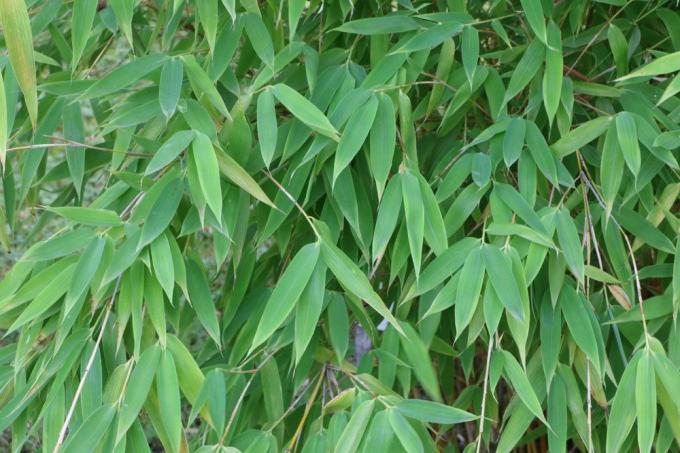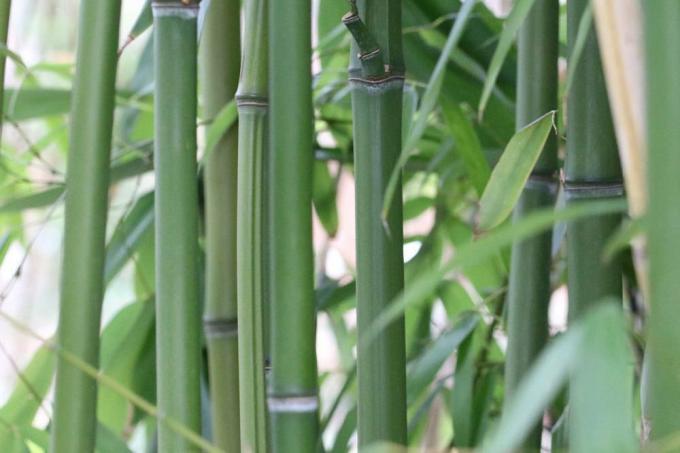
table of contents
- Suitable species
- Location
- Substrate
- Repot
- to water
- Fertilize
- Overwinter
- Multiply
- Pests
- Bamboo mite
- Aphids
- Mealybugs and mealybugs
- Scale insects
A pot of bamboo is an ideal way to green the balcony or to add Asian accents to your own property. If you are interested in purchasing the robust grasses, you should know about bamboo care know that the plants in the tub need significantly more attention than if they were planted outdoors will. Plants can be problematic, especially on the balcony or terrace.
Suitable species
One of the most important aspects of bamboo care is the selection of the appropriate species, because not every genus of the Bambusoideae should be planted in a pot. The potential height, weight and of course the notorious runners, which have to be kept in check with a rhizome barrier in the garden, must be taken into account. In view of these points, Fargesia species in particular have proven to be excellent for planting in pots pointed out, since these do not form runners and therefore not the container due to their growth bust. The following are particularly recommended:
- Umbrella bamboo (bot. Fargesia murielae)
- Fountain bamboo (Fargesia nitida 'fountain')
- Fargesia nitida 'Jiuzhaigou-Geneve'
- Fargesia spathacea
Although all Fargesia that do not grow too large are suitable for this purpose, the species and varieties mentioned have proven to be particularly decorative in planters. These present their charm especially on the balcony. You can also pot runners-forming species of the genus Phyllostachys in a planter, but they will never reach their actual final size. In addition, they have to be repotted annually, otherwise their runners have an easy time of it. When repotting these species, it is necessary to completely remove the runners so that these taxa do not break through the vessel. This can even happen with models made of stone.

tip: One of the most popular design elements in Asia is cut bamboo stalks that are stuck in sand. These look appealing on the balcony and terrace and do not require any maintenance.
Location
One of the essential points when keeping a bamboo in a bucket is its location. Choosing the balcony or terrace, you need to pay attention to the following characteristics of the site, so that it has a positive effect on the vitality of the grasses:
- Light requirement: sunny to shady
- Partial shade is tolerated
- high humidity throughout the year
- sheltered from the wind
In itself, bamboo taxa are very resistant and can be kept on all balconies as long as they are not too dark or are plagued by the wind. Especially if you live on the fifth floor or have a roof terrace, you have to be careful.
Substrate
Bamboo is quite demanding in terms of the substrate used and you should definitely use good quality soil. The Poaceae cannot tolerate compacted soil, which is a typical problem for poor quality. A mixture of the following is ideal:
- Clay
- sand
- Pine bark (grain size 7 to 15 millimeters)
- Clay granules
Alternatively, you can use a bamboo or standard soil and enrich it with seramis and a little rock flour.
Repot
Because of the untamed growth of bamboo, repotting is immensely important in order to provide the plant with sufficient nutrients in the long term and to protect the soil from compaction. The selection of the pot is essential for healthy bamboo species. You should pay attention to the following data:
- Material: metal, wood, plastic, basalt
- Shape: angular
- Drain holes are necessary
Square pots are recommended as they will help stabilize the weight of the plant outdoors. So that the grasses do not get too hot in summer and too cold in winter, you should lay out the bucket with Styrodur panels that are 3.5 to four centimeters thick. Even the floor has to be covered and for this reason has drainage holes. In addition, the new pot has to be about three centimeters larger in circumference. A drainage system is laid out on the floor, which must be between five to ten centimeters thick. The following materials are suitable for this:
- Crumbled Styrodur or Styrofoam
- Seramis
- Expanded clay
- gravel
- Grit
The smaller the pot, the thinner the drainage can be, measuring as little as two centimeters. Polystyrene in particular is often used as a drainage layer, as the roots of the bamboo plants tend to grow into it and hold onto it in this way.
- Carefully lay the bamboo on its side
- pull out of the pot
- remove a little old soil
- check roots for rot
- Simply cut away rotten things
- Fill fresh substrate into the new pot
- Insert bamboo
- fill up with substrate
Finally, carefully press the substrate on and then moisten it with a spray bottle. In the near future, pay more attention to the plant's water requirements.

tip: It is imperative that you repot your bamboo immediately after purchase, as the substrate has in most cases already used up most of the nutrients and significantly restricts the growth of the plant.
to water
Watering or watering a bamboo in the bucket is a difficult subject because the plants need a lot of water. At the same time, it shouldn't be watered too much, because Waterlogging is very dangerous and can quickly lead to the death of the plant. The following tips will help you with watering:
frequency
When caring for bamboo, it is important to water all year round, as Bambusoideae are evergreen plants. Especially over the summer months you should have the substrate over one every morning Finger test check and pour accordingly. You should never water over midday, otherwise the water will evaporate too quickly, especially in the pot.
Shower off
Instead of administering irrigation water over the substrate, you can shower the plants sufficiently. Because bamboo species absorb a lot of moisture through their leaves and so the spray bottle is the ideal tool for watering. This alternative is particularly recommended over the summer, as the leaves dry out quickly when it gets hot, even if the care is right.
water
Bamboo can withstand hard water, but is much more happy about soft water. Just Rainwater is very popular, which you can take advantage of outdoors on the balcony. A small rain shower does not harm the plant.
Make sure that no waterlogging forms. If the substrate is too wet, it is imperative that the plant utilize the excess water first.
Fertilize
Fertilizing is not as difficult a part of maintenance as watering. Bambusoideae need a special one in Germany Bamboo fertilizer, which you administer via the irrigation water every four to six weeks from the end of March to the end of June. Alternatively, use a liquid complete fertilizer with long-term effects and a lot of nitrogen.
Overwinter
Wintering Fargesia and other types of bamboo has its own pitfalls. Above all, the water supply should be mentioned here. Water regularly and check the substrate beforehand using the finger test. You should never spray the leaves over the cold season as this could lead to freezing. If you have covered the pot with Styrodur and the location is right, it does not need winter protection. Otherwise, wrap the crop in the following way:
- Place in a sheltered location (keyword: house wall)
- Tie the straws together
- Wrap the bucket with coconut mats or bubble wrap
- Cover stalks with fir branches or garden fleece
- Fleece must be breathable
Alternatively, place the bamboo plant in a conservatory or an unused, cool room. The location should be bright but protected from the winter sun. Normal bamboo care can be taken up from the end of March.
Multiply
Bucket bamboo is propagated like any other bamboo by division. To do this, the plant must be removed from the pot and the entire plant divided in half. Even the pieces can be divided into further copies, thus increasing the number of copies that you can pot. Use one of the following tools to share:
- Axe
- spade
- Ironing ax
You can easily dispose of damaged straws. However, only use disinfected and sharp tools.
Pests
Diseases are quite rare in bamboo species, even in the bucket. The grasses are not really susceptible to bacteria, fungi or viruses, but pests can really get to them. These attack the plant sap and the green, which is important for the vitality of the Bambusoideae. The following four pests are typical and must be controlled:
Bamboo mite
The bamboo mite occurs mainly in southern Germany and can be recognized by the bright spots that extend from the leaf stalk and can be seen on the upper side of the leaf. The infected leaves must be removed, the humidity increased and chemical agents used in an emergency.
Aphids
Aphids do not stop at potted bamboo and are mainly recognizable by a dark coating. In addition, the lice can be seen on closer inspection. You should remove severely withered parts and sprinkle the rest of the plant with a broth made from horsetail (bot. Equisetum).
Mealybugs and mealybugs
Even these pests don't stop at the grasses. They settle under the stalk sheaths and can weaken the plant in the long run. Once you're looking greasy lice you need to collect them and use a canola oil and water spray. If that doesn't help, the chemical club is unfortunately used.
Scale insects
Scale insects can be recognized by their shields, which are available to the arachnid as protection. They occur mainly during the winter and are dragged inside from the balcony. They then have a good chance of survival in the house. Cover the pot with cling film and carefully wipe off these lice. Then use a rapeseed oil spray and if that is not enough, you have to use chemicals.
If you need to use chemical agents against the pests, you should contact a bamboo expert beforehand. They know exactly which means are suitable. This is important because these should not be too aggressive, as bamboo in the bucket is often more sensitive to chemicals.

tip: In rare cases, botrytis fungi, the gray mold rot, can be infected. come when the bamboo has to endure waterlogging. In the case of withered stalks, you should remove the infected parts of the plant and repot immediately so that the plant receives fresh substrate and no longer suffers from the unfavorable conditions.

